Attaching the front to the dishwasher
 After purchasing a built-in dishwasher, the user is faced with not only the task of how to connect it to the drain or water supply, electrical communications, but also how to hang the front on the door. Most entrust this task to furniture makers and only a few hang the façade themselves. What is needed for such work, how to carry out installation - we will answer these questions.
After purchasing a built-in dishwasher, the user is faced with not only the task of how to connect it to the drain or water supply, electrical communications, but also how to hang the front on the door. Most entrust this task to furniture makers and only a few hang the façade themselves. What is needed for such work, how to carry out installation - we will answer these questions.
Facade and its purpose
A dishwasher facade is a decorative panel, which is usually made from the same material as kitchen furniture facades. It is attached to the door. The facade allows you to hide the dishwasher in such a way that it is not always possible to understand that it is the dishwasher and not the cabinet that is hidden behind it.
Fully built-in dishwashers 45 or 60 cm with hanging facade have some advantages:
- they make the choice easier, from the point of view of the design component, there is no need to match the color of the dishwasher to the color of the kitchen or other furniture, it will still be hidden, which means it will fit perfectly into the interior;
- the control panel is not noticeable, which means that small children will not press the buttons again;
- thanks to the facade, you can’t hear the noise of the car during washing.
The facade is most often made of MDF 16 mm thick; it can be laminated MDF or covered with a colored film, and therefore the color and texture of the facade can be any. And one more thing, in some built-in dishwashers the open door is fixed only after the front has been installed.
Decorative panel dimensions
The size of the front will primarily depend on the size of the dishwasher.In width these are mainly machines of 45 and 60 cm, the height of most built-in machines is 82 cm. But there are compact models with a height of 60 and 50 cm.
Important! We have given the average size of the cars (60 and 45 cm); models can differ from each other in width and height from a few millimeters to several centimeters.
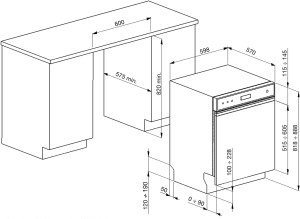 Experts recommend first choosing a 60 cm or 45 cm dishwasher, determining its size, and only then ordering furniture for the kitchen. In this case, there is less chance of making a mistake with the size of the niche for the dishwasher and, accordingly, the size of the facade. Indeed, in reality, a dishwasher may have a width of not 60, but 59.2 cm, not 45, but 44.6 cm, which is very significant. An incorrectly manufactured facade can no longer be trimmed, since its appearance will deteriorate, since the end parts of the facade, as well as its front side, are laminated or covered with film.
Experts recommend first choosing a 60 cm or 45 cm dishwasher, determining its size, and only then ordering furniture for the kitchen. In this case, there is less chance of making a mistake with the size of the niche for the dishwasher and, accordingly, the size of the facade. Indeed, in reality, a dishwasher may have a width of not 60, but 59.2 cm, not 45, but 44.6 cm, which is very significant. An incorrectly manufactured facade can no longer be trimmed, since its appearance will deteriorate, since the end parts of the facade, as well as its front side, are laminated or covered with film.
As for the height of the dishwasher façade, it must also be clearly calculated. The height of the dishwasher front is slightly greater than the height of the dishwasher door. In order for the facade to be flush with the countertop, you will have to adjust not the facade, but the legs of the dishwasher so that it fits clearly under the countertop. What the height of the facade will be in a partially built-in dishwasher will depend on the width of the control panel located on the door. Hanging such a facade is a little easier than in fully built-in models.
We hang the decorative panel ourselves
The front of the dishwasher should be hung only after the dishwasher is connected to the water supply and drain. In addition, you need to install the dishwasher in a niche that is reserved for it. To carry out the work you may need:
- roulette;
- screwdrivers;
- fasteners;
- handle for opening the door;
- the façade itself.
Let's celebrate! Many built-in dishwashers come with instructions for attaching the front and a special template for marking. Bosch and Siemens models even include a special screwdriver.
So, Before installing the front, the dishwasher is attached to the side walls of adjacent cabinets and to the countertop. After this, you need to screw the handle on the front side of the facade to open the door. To do this, you need to carefully make holes for the screw using a drill. The drill should be thinner than the screw, and you need to drill from the front side. This way you will avoid chipping on the facade.

Next, you need to determine the distance (Z) at which the facade fastening points should be located. This is necessary so that the edge of the dishwasher front is flush with the edges of the fronts of adjacent cabinets. Using a tape measure, measure the gap between the countertop and the front of the adjacent cabinet (distance x), then measure the distance from the top fastening of the front to the countertop (distance y). Now we calculate Z=y-x, this will be the required size - the distance from the attachment point to the edge of the dishwasher facade.
After the measurements, take the template from the kit and attach it to the inner surface of the facade with tape, according to the calculations obtained. It’s better to double-check everything several times, and if possible, practice on a piece of unnecessary MDF. So, using a template, mark the points for the mounting holes. Then you drill holes so that the drill does not go through, ¾ of the thickness of the facade is enough, otherwise there will be holes. You can do without drilling, but this type of fastening is more reliable.
And finally, fix the facade with screws.In some models, it is necessary to unscrew the short ones and screw in the long screws in their place, which will tighten the door and the facade together. The installation may not end there. First, check how the door opens, whether it rests against the plinth at the bottom, and how tightly it opens.
Important! The degree of tension of the dishwasher door is adjusted using bolts located at the bottom of the machine on the sides.
If the façade rests against the plinth when opening, which can happen due to miscalculations, you will need to make a small gap in the plinth. The size of this gap will be equal to the thickness of the facade plus 2-3 mm. This is a completely acceptable option, especially when it is not possible to adjust all the facades to the same level by tightening the legs of the furniture and the dishwasher.
So, installing a decorative panel on the door of a 60 or 45 cm built-in dishwasher should not be difficult if everything is calculated correctly and the size of the facade is adjusted to the size of the appliance. We hope our tips will help you in your work, good luck!
Interesting:
Reader comments
- Share your opinion - leave a comment
Categories
Washing machine repair


For buyers

For users

Dishwasher



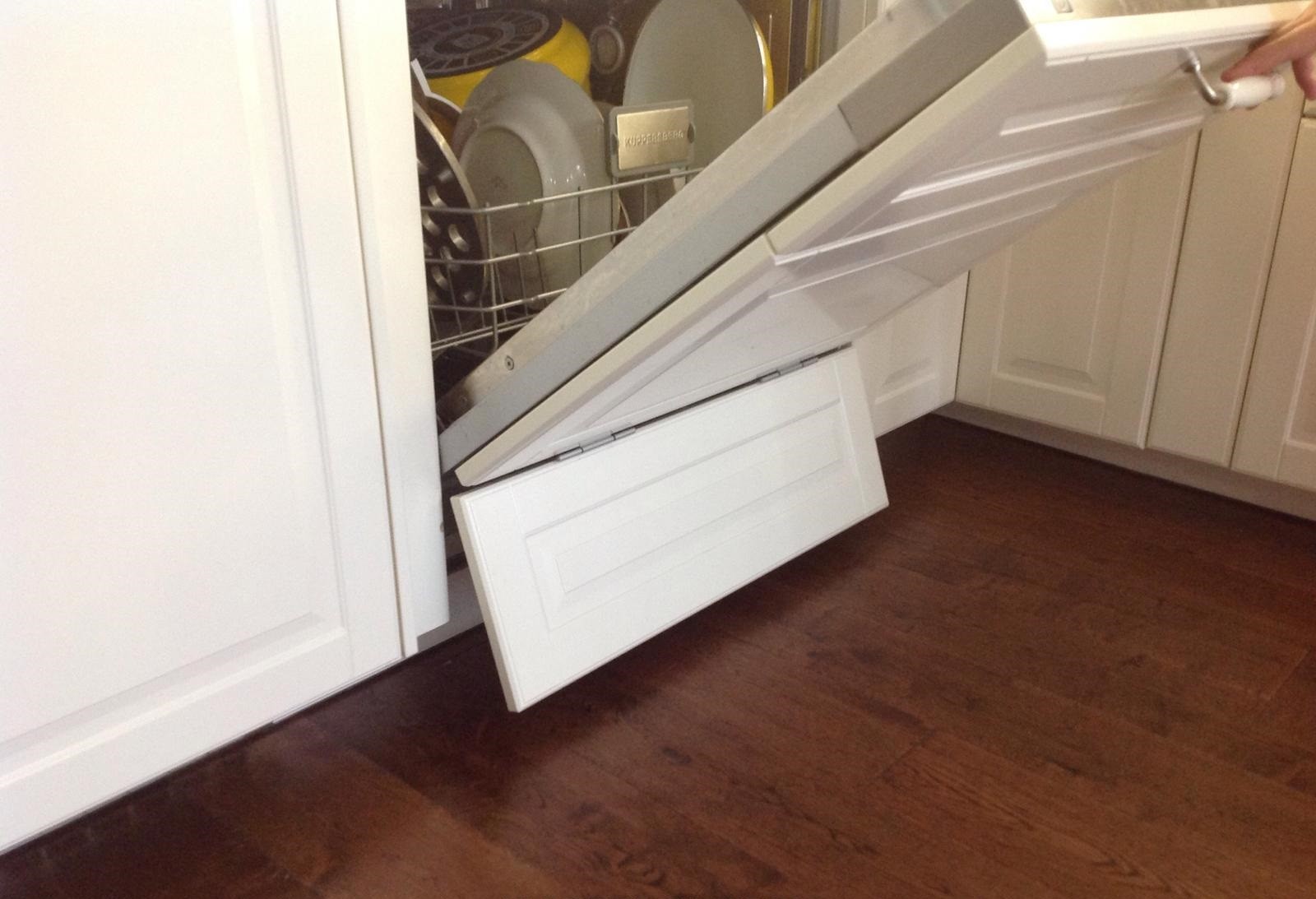
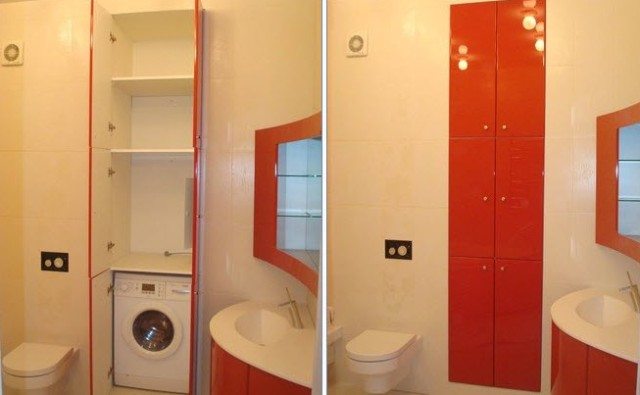
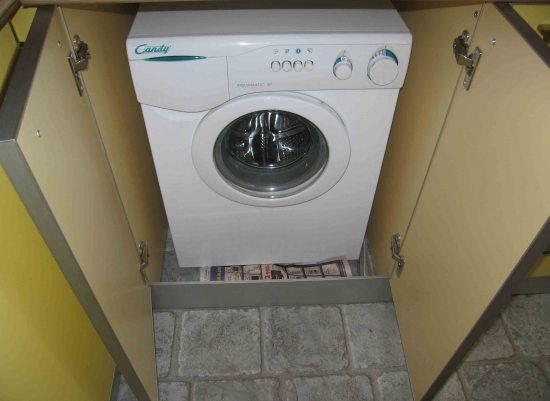
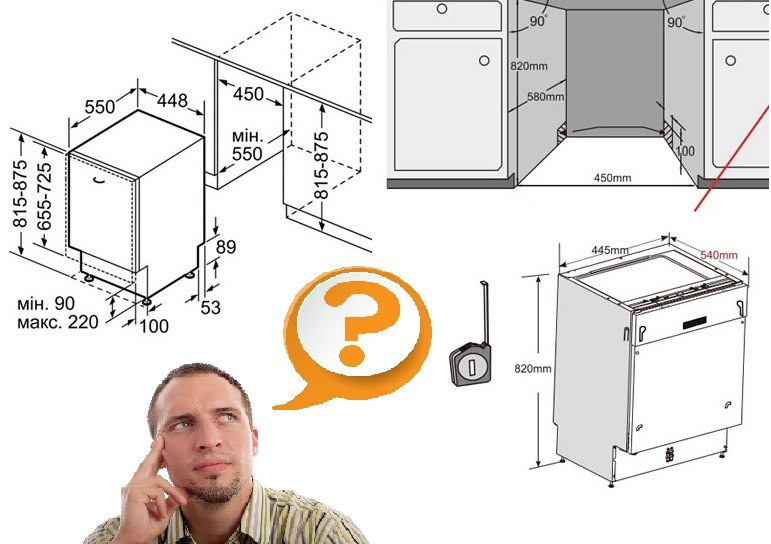










Add a comment